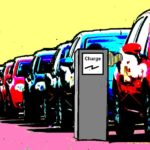Energy efficiencies made possible by gallium-nitride semiconductors are starting to impact every day products.
Paul Wiener • GaN Systems, Inc. | Ron Stull • CUI, Inc.
Wide-bandgap power semiconductors are in production now and recommended for new designs. The earliest adopters among power supply OEMs have already begun introducing new product lines employing this technology to deliver smaller size, greater efficiency, and more power than their predecessors. As ordinary silicon-based power reaches the end of its roadmap, it’s time for power supply specifiers to change gear.
Silicon-based semiconductors, from processors to power transistors, have enabled tremendous advances in the way the world lives and works. From the invention of the p-n junction in the 1930s-40s through the periods of exponential progress highlighted by observations such as Moore’s Law, the electronics industry has become the global phenomenon it is today, largely built on silicon.

We know, however, that as a technology matures, the gains from each iteration diminish while it takes more effort to realize them. Then, typically, a new technology arrives and changes the game. There is a leap forward followed by a period of rapid progress.
Commercially, these technological singularities can be dangerous for market leaders. At times of disruption, new upstarts can quickly eclipse those intent on wringing the last few drops of potential from the old ways.
This sort of event is happening right now in power conversion. A new generation of power supplies and converters is arriving based not on silicon devices but instead on newer wide-bandgap power semiconductors. Among these, gallium-nitride (GaN) power transistors now enable significant advances in power density, efficiency, and thermal performance when the need is for breakdown voltages up to about 600 V.

Switched-mode power supplies designed with GaN devices can operate efficiently at a switching frequency higher than is workable with ordinary silicon components. The efficiency gain is so great that the PSU can operate at the full rated power with only a small heatsink or, sometimes, no heatsink at all. Also, the higher frequency allows smaller magnetic components and capacitors to condition the power supply output. Overall, a GaN PSU can be half the size or smaller than a comparable silicon-based design.
These space savings are important for organizations that buy power supplies. For example, consider internal power supplies. These are often the last item to be considered in the design of a new product. There can be problems if commercial supplies don’t fit the space left over after the main design work has been done. Being inherently smaller, GaN-based PSUs can help alleviate such issues.
GaN-based external adapters, on the other hand, can be half the size or less of conventional units. The smaller size gives consumers the chance to declutter their environment. For example, imagine the effect in a commercial gym that has row upon row of exercise machines. CUI has recently introduced a family of GaN-based power adapters in a technical collaboration with GaN Systems. Units are available off the shelf in various popular power ratings up to 160 W and further models are planned.
OEMs choosing the new GaN adapters can instantly get a competitive advantage over similar products based on ordinary silicon. Moreover, GaN’s efficiency advantage helps ensure the environmental performance that is both mandated by legislators and demanded by markets.
GaN power semiconductors are driving improvements in numerous industries. In automotive applications, for example, size reductions in power-conversion circuitry allows what was formerly dead space within a vehicle to become usable. Suddenly, ECUs or modules can squeeze into previously impossible positions and enable extra value-added features or facilitate exterior styling that ushers in a sleek new look.
Sleekness also helps win the hearts of gamers. The thinnest laptops are prestige items, and ambitious GaN designs dramatically cut the vertical height of the computer power supply to make possible dramatic low profiles. In television design as well, thin is “in.” Power supplies using GaN transistors have helped realize ultra-low-profile designs that make the most of extremely thin display technologies such as OLEDs.

Another application is in data center server blades where GaN technology has made it possible to shrink on-board power modules to about 30% of the accepted normal size. A typical conventional power module measures 185×70 mm and one blade typically requires two of them. GaN thus liberates the board space occupied by more than one entire module.
Numerous other applications can benefit from the size reduction and efficiency made possible by GaN power semiconductors. Examples include mobile chargers, ac/dc power supplies and inverters for energy storage and power conditioning, blockchain processing, powered hospital beds, drives for autonomous guided vehicles, e-mobility systems, and others.
Additionally, GaN is enabling new switching-circuit applications not feasible using conventional silicon transistors. These include aircraft wing de-icing, making use of GaN transistors’ ability to switch efficiently at extremely high frequencies; and high-quality class-D audio amplifiers that take advantage of extremely fast and clean GaN switching transitions to create close-to-perfect square waves that permit simplified filtering with reduced distortion.
GaN now enables leading electronics brands to make a leap. Product designers and specifiers can take advantage of the emerging generation of high-efficiency power supplies and adapters to trim dimensions, boost performance, and save energy as well as explore new applications.







Leave a Reply